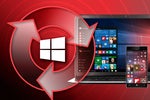Why enterprises should embrace remote work in 2023

Many businesses are looking to cut costs as economies face recession, but some enterprises may be ignoring one of the most effective ways to trim the fat while boosting productivity — by embracing remote working.
The power is in your hands
We know Macs, iPhones, and iPads have been seeing increased deployment across the enterprise. We also know (because IBM, SAP and so many companies tell us) that businesses that embrace Apple kit also see reduced overall cost of ownership and lower tech support costs. Employee choice delivers big benefits.





